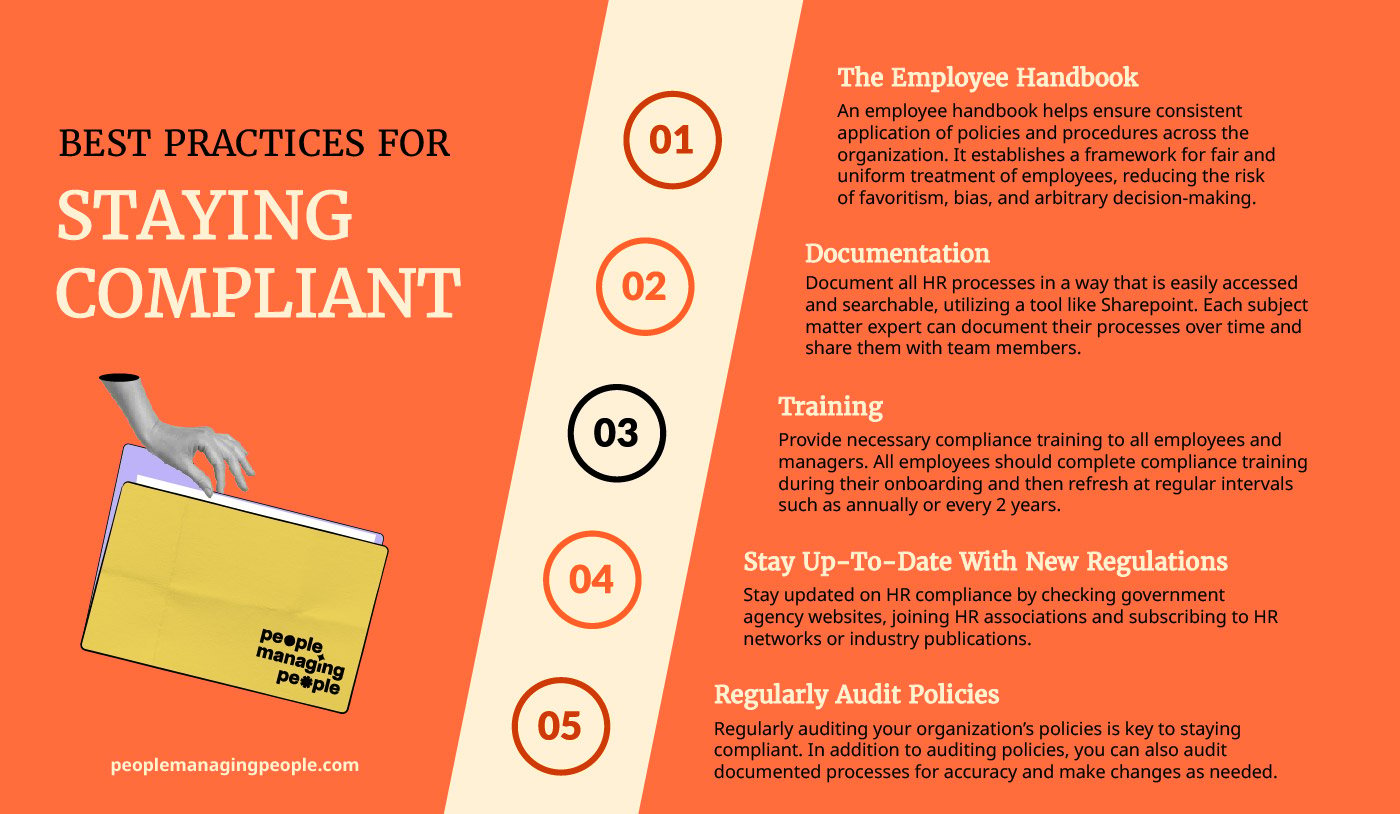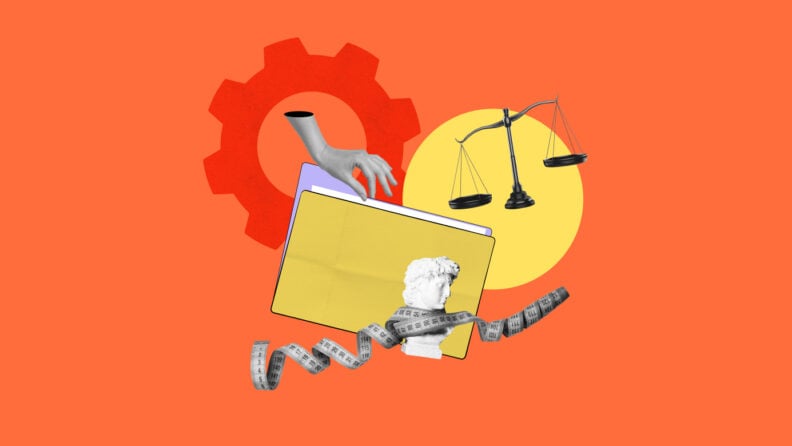HR compliance is an important component of every human resources professional's job, but it doesn't have to consume every working hour.
In this article, I’ll talk about what HR compliance is and why you should care about it, some common compliance issues that can surface, and strategies to help you stay on top of it all.
What Is HR Compliance And Why Is It Important?
HR compliance refers to an organization’s adherence to the laws, regulations, policies, and procedures that govern employment practices, the physical workplace, and the treatment of employees.
This covers various areas, including hiring practices, employee classifications, compensation and benefits, workplace safety, discrimination and harassment policies, employee records management, and labor relations.
HR compliance is important for several reasons, the most obvious being legal compliance, but it’s not the only reason. Let’s discuss some other implications.
Risk mitigation
Compliance reduces the risk of employment-related disputes such as discrimination claims, wage and hour violations, or wrongful termination cases, and helps protect the organization from potential liabilities and legal disputes.
Compliance with domestic labor laws and international employment laws and regulations helps organizations avoid legal penalties, fines, and lawsuits. Non-compliance can lead to costly legal battles, damage to reputation, and negative financial consequences.
For example, recently, a federal court required East Penn Manufacturing Co to pay $22.25 million for wage and hour violations, one of the largest recorded jury verdicts under the Fair Labor Standards Act (FLSA).
Employee well-being
Compliance ensures that employees are treated fairly and equitably, promoting a positive work environment and bolstering retention. It includes maintaining non-discriminatory practices, providing safe working conditions, and upholding labor rights.
Reputation and trust
Organizations that prioritize HR compliance demonstrate their commitment to ethical and responsible business practices. This enhances their reputation among employees, customers, investors, and the public. It can attract and retain top talent and lead to improved performance and competitiveness.
Common compliance issues
HR compliance touches every aspect of employment from job postings to terminations. Labor laws are complex and can range from federal laws to local laws and regulations. Now we’ll discuss common compliance issues that HR professionals may see.
Workplace discrimination
Failure to prevent or address workplace harassment or discrimination, based on protected characteristics, is a serious HR compliance issue and one that is unfortunately common.
The Equal Employment Opportunity Commission (EEOC) reported that it resolved 140 discrimination lawsuits in 2021, resulting in a monetary benefit of $39.7 million.
For example, you can use pay equity software to analyze compensation data, identify wage disparities, and implement equitable pay structures without bias.
Security and data privacy
Another frequent compliance concern for companies is inadequate protection of employee records, mishandling of sensitive employee data, or non-compliance with data privacy regulations (which can vary by state). For this reason, it's necessary to choose HR software with proven security features.
Incomplete documentation of eligibility to work
Compliance with the Form I-9 can be complex and is another common compliance issue HR professionals encounter.
Fortunately, it is also one that has clear guidelines on how to stay compliant. The USCIS publishes a staff handbook for employers on how to verify a new hire’s eligibility to work the in US.
Discriminatory hiring practices
Discrimination in hiring based on protected characteristics such as race, gender, age, or disability is another compliance area that can be complicated to navigate during the interview process.
Recently, several states have added pay transparency laws that require job listings to display a salary range for the position.
Here's Mariya Hristova's excellent guide to recruitment compliance.
Worker misclassification
FLSA rules and the misclassification of employees as independent contractors can be especially difficult aspects of HR compliance for companies to navigate. In addition to minimum wage adjustments, overtime rules can present their own challenges.
Leave entitlements and disability accommodations
Failure to comply with leave entitlements such as the Family and Medical Leave Act (FMLA) and Americans with Disabilities Act (ADA) are an easy misstep for employers to take and even more so now that so many states and municipalities have enacted their own leave entitlements.
Employee benefits
Employee benefits such as health insurance, cafeteria plans, and other perks are wonderful offerings for employees.
However, they all come with their own rules and regulations, such as COBRA notices and ERISA rules for certain healthcare coverages.
Health and safety
Employers must adhere to relevant health and safety laws and regulations. These laws cover OSHA rules, and incident reporting among other industry-specific regulations. They often outline requirements and standards that businesses need to meet to ensure safety in the workplace.
Union interference
There is a fine line between union prevention and union interference. According to the National Labor Relations Act (NLRA), you cannot interfere with employees’ rights to organize and collectively bargain for terms and conditions of employment (find out more about this by taking a labor relations certification).
Best Practices For Staying Compliant
If you’re feeling overwhelmed, and I can certainly sympathize there, keep reading as I share some best practices for staying compliant.

The employee handbook
An employee handbook helps ensure consistent application of policies and procedures across the organization. It establishes a framework for fair and uniform treatment of employees, reducing the risk of favoritism, bias, and arbitrary decision-making. You can use employee handbook software to help create yours.
Documentation
Document all HR processes in a way that is easily accessed and searchable, utilizing a tool like Sharepoint. Each subject matter expert can document their processes over time and share them with team members.
Standardizing HR processes such as leaves of absence, accommodations, hiring, and onboarding can help alleviate risk. These processes need to be maintained and updated (more on that later).
In addition to documenting clear policies and procedures, you need to maintain accurate records, including formal and informal HR documents of key moments in an employee’s journey, such as contributions, performance reviews, disciplinary actions, and policy violations.
A comprehensive HRIS can assist with this and help ensure that employee records are stored appropriately according to applicable laws.
Training
Provide compliance training to all employees and managers. All employees should complete compliance training during their onboarding and then refresh at regular intervals such as annually or every 2 years.
Ensure HR teams and managers are knowledgeable about leave laws and accommodation requirements, can communicate with employees about their rights and entitlements, and ensure they understand the company’s process for reviewing and approving accommodation requests.
Hiring managers often need reminding of HR compliance items such as proper interview questions prior to speaking with candidates. Managers may also need education on union prevention vs interference, as well as other HR compliance issues.
Stay up-to-date with new regulations
From the latest employee misclassification guidelines to new rules about remote work from the ADA, there's always some new compliance concern to keep up with.
Stay informed by regularly checking the websites of relevant government agencies responsible for labor and employment regulations.
These websites often provide updates on new laws, changes in regulations, and guidance documents to help you understand and comply with HR requirements. A good example is something like the WARN Act and whether it applies to remote workers. This is an area that where new guidance could emerge at any time, staying up to date with the latest from the U.S. Department of Labor will ensure you don't end up on the wrong side of the law.
It would be wonderful if all these updates were in one place but, until then, the Department of Labor has a compliance assistance website, which links out to resources and relevant laws.
If you haven’t done so already, join professional HR associations and networks that provide resources, updates, and training on HR compliance. These organizations often offer newsletters, webinars, conferences, and forums where you can learn about the latest trends and changes in HR legislation.
If your company utilizes outside counsel for legal matters, they likely offer a service that provides relevant updates to you. If not, you can stay abreast of changes by subscribing to HR networks like SHRM and relevant industry publications.
Regularly audit policies
Regularly auditing your organization’s policies is key to staying compliant. In addition to auditing policies, you can also audit documented processes for accuracy and make changes as needed.
My HR department has a compliance calendar that highlights important dates and tasks, such as filing deadlines for taxes, benefits enrollment periods, and training requirements. This calendar serves as a reminder to complete necessary tasks in a timely manner.
The calendar is an Excel spreadsheet that is saved in Sharepoint. While I can’t share the entirety of the calendar with you, this is a peek at the few last weeks of the year.

Laws And Regulations HR Professionals Should Know
Laws and regulations will vary depending on your location, so it’s important you keep up to date with any developments in your territory.
Some prominent laws in the US are:
- Fair Labor Standards Act (FLSA)
- Americans with Disabilities Act (ADA)
- Affordable Care Act (ACA)
- Family and Medical Leave Act (FMLA)
- National Labor Relations Act (NLRA)
- Title VII of the Civil Rights Act
- Occupational Safety and Health Act (OSHA)
- Equal Pay Act (EPA)
If you’re operating internationally, utilizing an employer of record can take all the hassle out of keeping up to date with foreign employment laws. You can also use Alice Ferretti's useful guide to global HR compliance.
Different Types Of HR Compliance
- Statutory compliance: Adherence to government legislation such as the FLSA and FMLA.
- Regulatory compliance: Rules of specific regulatory bodies such as the Federal Trade Commission (FDC) or US Environmental Protection Agency (EPA). Sometimes overlaps with statutory compliance.
- Contractual compliance: Contractual compliance in the context of Human Resources (HR) refers to the process of ensuring that all employment contracts and agreements are in accordance with legal regulations and company policies.
- Union law compliance: Some organizations have to deal with unionized workers, such as the Screen Actors Guild. In such cases, HR must be aware of and comply with any relevant federal, state, and local laws regarding labor relations and union activities.
Using resume screening platforms can help organizations adhere to HR compliance standards by creating a fair, standardized process.
Stay Proactive About Compliance
Compliance is one of the core HR pillars. By following best practices and staying proactive in monitoring the regulatory landscape, HR teams can effectively manage compliance responsibilities, minimize risks, and create a positive and compliant work environment.
Leveraging the capabilities of cutting-edge HR compliance software and knowing the tool costs associated can be a strategic move to stay ahead in the compliance game, ensuring that your organization is always prepared and up-to-date with the latest compliance requirements.



